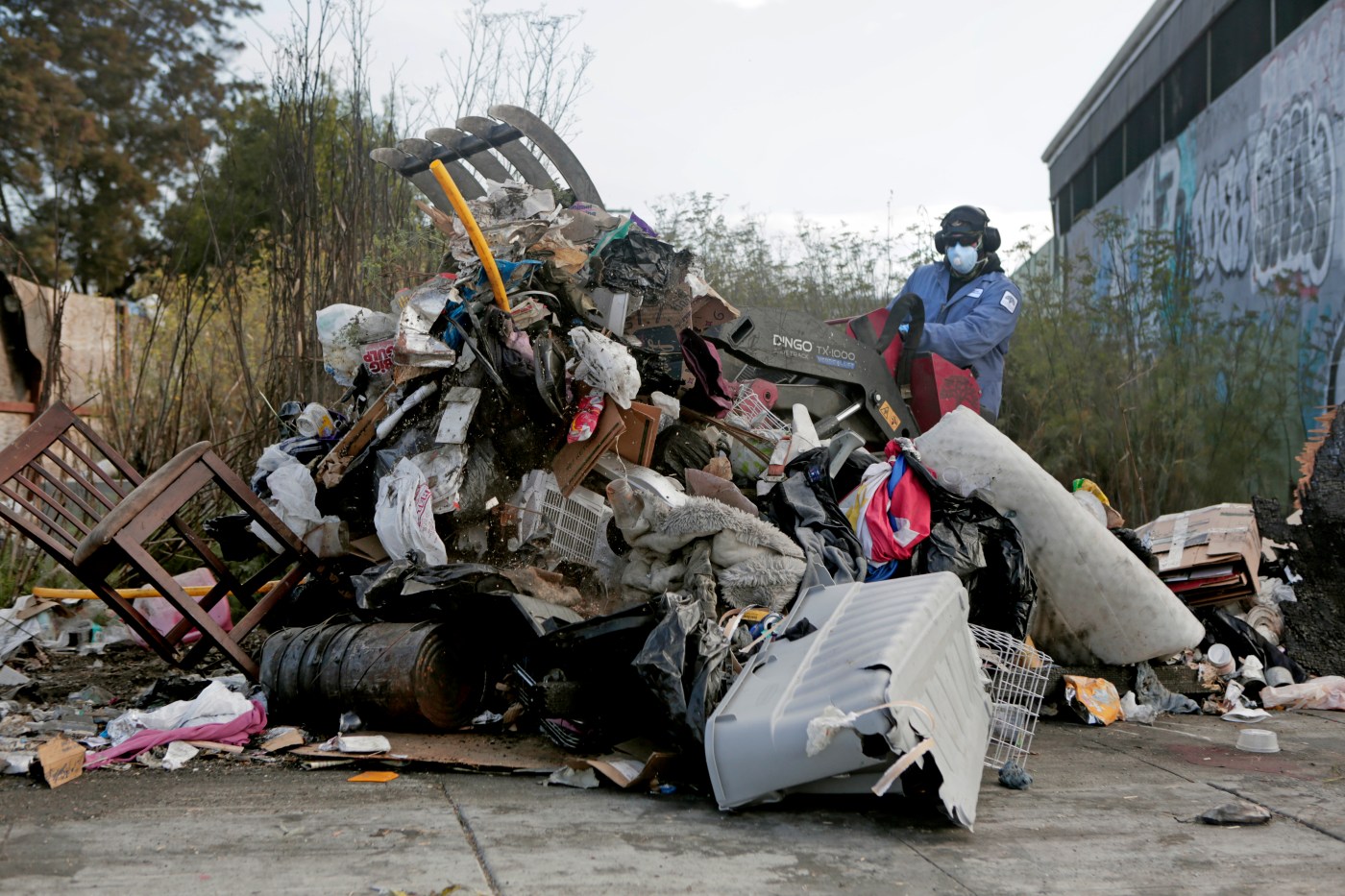Underneath an overpass on Martin Luther King Jr. Boulevard and 36th Street in Oakland, a stripped 17-foot 1981 Bayliner boat is stranded in a sea of plastic wrappers, broken furniture and bike frames — one of the more conspicuous objects to be found in the many illegal dumpsites throughout the Bay Area.
A boat and discarded items accumulate on Martin Luther King Jr Way sidewalk near 36th Street in Oakland, Calif., on Tuesday, Sept. 16, 2025. (Ray Chavez/Bay Area News Group)
This nautical eyesore aside, Alameda County has been lauded as one of the foremost policymakers in combating illegal dumping in recent years, launching a pilot program in 2018 that has evolved into a regional and statewide strategy. The county’s aggressive efforts on the issue will be shared with other Bay Area leaders at a conference in October to galvanize support for a coordinated response to the problem.
RELATED: Despite more dumpster days and free junk pickup, illegal dumping continues to plague San Jose
“There is no ‘one size fits all’ approach — we need comprehensive solutions that prevent illegal dumping, remove it quickly, and hold dumpers accountable,” Alameda County Supervisor Nate Miley said in an email to Bay Area News Group.
Related Articles
East Bay resident gets 8½ years in federal prison for receiving child pornography
Four sentenced for killing Oakland man in RV robbery shootout
Man shot after dispute near Lake Merritt dies of his wounds
Two dead, two hospitalized following shooting in Antioch
Walnut Creek man allegedly killed two women, staged crime scene
Miley has made addressing illegal dumping a priority in his office since 2016, developing the multi-agency Alameda County Illegal Dump (ACID) Taskforce, which launched in 2018. The task force created a blueprint that can be applied across the county. During the year-long pilot, the task force removed over 50 tons of trash and issued more than 100 citations as it focused on notorious illegal dumping sites in East Oakland on Railroad Avenue and G Street.
The pilot program identified a “three-prong strategy” dubbed the 3Es: education, eradication and enforcement. Alameda County and Oakland officials said the program showed measurable success when it was supported by funding and prosecutorial follow-through, but that former Alameda County District Attorney Pamela Price “did not engage in the pilot,” limiting its enforcement power, according to a statement from Miley’s office.
As in many cities across the state, illegal dumping skyrocketed in Oakland during the pandemic. Between July 2020 and June 2021, Oakland public works crews picked up 70,000 cubic yards of illegally dumped trash, according to city data.
Keep Oakland Beautiful and Clean workers, a division of Oakland Public Works department removes a large trash pile along International Blvd. at 71st Avenue in Oakland, Calif., on Friday, Sept. 19, 2025. (Laura A. Oda/ Bay Area News Group)
“A lot of people think it’s easy to address illegal dumping. ‘Just put a dumpster there,’ ‘just make the dump free,’” said Erin Armstrong, the director of policy and strategic initiatives for Miley’s office. “But the longer you work in this field, the more you understand that you have to address the root causes.”
The 3Es strategy became the centerpiece of the first inaugural statewide conference on illegal dumping in 2021, prompting Bay Area cities like San Jose, Oakland and Hayward to adopt Alameda County’s blueprint, in addition to Los Angeles and Yolo Counties. Alameda County officials emphasized the need for a comprehensive approach to rooting out illegal dumps.
Maintenance Workers for the City of San Jose, left, and Javier Valencia, a Maintenance Worker 2, picks up trash that has been illegally dumped on Cadillac Drive in San Jose, Calif., on Tuesday, Aug. 19, 2025. Stretches of San Jose streets have become dumping grounds for unwanted household items, including mattresses, stoves, and refrigerators. But after a concerted effort to crack down on blight, city officials believe they are making progress to curb residents from discarding their unwanted junk. (Doug Duran/Bay Area News Group)
The Urban Compassion Project, an Oakland-based nonprofit focused on cleaning up urban blight, has organized volunteer weekly clean-ups of the most blighted areas of the East Bay. The organization claims to have eliminated more than 2,400 tons of trash. Monday night, representatives of the group alerted the Oakland Police Department about a person illegally dumping trash on 26th and Perala Street.
Increased penalties for illegal dumping are one of the new strategies in the city of Oakland to punish dumpers, Oakland councilmember Ken Houston told Bay Area News Group.
“If you have someone fined $750 for dumping $10,000 in trash, then you haven’t done anything,” said Oakland councilmember Ken Houston, who partnered with Miley to launch the pilot program in 2018. “But if you could get a felony charge for dumping hazardous materials, you’re going to think about that twice. It’s a deterrent mechanism.”
Illegal dumping has returned to pre-pandemic levels, Armstrong said, but it remains a pernicious issue for many California communities – and cracking down on blight in one area often pushes it to another. It’s crucial, she added, that municipalities pursue a coordinated response to prevent service gaps and duplicated efforts to address blight.
Alameda County will host a regional conference on Oct. 29 with Bay Area leaders to release the findings of a survey of 300 experts across the state on illegal dumping, unveil a new illegal dumping ordinance with enhanced penalties for unincorporated communities, and request Alameda County cities to pass similar ordinances to take out the trash for good. The next statewide Illegal Dumping Conference, known as IDCon5, will be held April 30 through May 1, 2026.
“That’s why coordination is so important,” Miley said, “so that each city and county isn’t reinventing the wheel. We need to be talking with each other; sharing what works and what doesn’t.”





